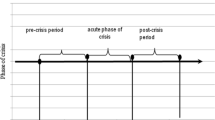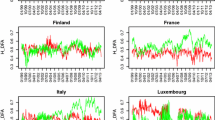Abstract
This study examines the long memory properties in the volatility of the foreign exchange markets of Egypt, Ghana, Kenya, Nigeria and South Africa. Applying the FIEGARCH model to daily data from June 2, 1997, to December 31, 2021, we find long memory in the second moment of return innovations across all five countries' foreign exchange markets and significant first-order positive autocorrelation. To isolate spurious long memory, we perform a structural break test and find that structural breaks in all five foreign exchange markets do not affect long memory. The findings may have implications for risk management. Historical volatility-based investment methods can generate risk-adjusted returns innovations. Long memory may indicate unexploited profit for risk-seeking speculators and international investors in these countries' financial assets. Also, official intervention should be random and rule-changing to reduce currency market predictability.
Similar content being viewed by others
References
Aidoo EN, Bashiru IIS, Ababio KA, Nsowah-Nuamah NN, Munyakazi L (2012) Analysis of Long Memory Dynamics in Exchange Rate. The Empirical Economics Letters 11:745–754
Amewu G, Junior PO, Amenyitor EA (2022) Co-movement between equity index and exchange rate: fresh evidence from Covid-19 era. Scientific African 16:e01146
Aron J (1997) Foreign exchange market efficiency tests in South Africa. Department of Economics, Oxford University Press Southern Africa (Pty) Ltd, Centre for the Study of African Economies
Aron J, Ayogu M (1997) Foreign exchange market efficiency tests in Sub-Saharan Africa: Econometric analysis and implications for policy. J Afr Econ 6:150–192
Assaf A, Cavalcante J (2005) Long-range dependence in the returns and volatility of the Brazilian stock market. European Review of Economics and Finance 5:5–20
Ayogu MD (1997) Return predictability: Evidence from Nigeria’s foreign exchange parallel market. J Afr Econ 6:296–313
Bai J, Perron P (1998) Estimating and testing linear models with multiple structural changes. Econometrica 66:47–78
Bai J, Perron P (2003) Computation and analysis of multiple structural change models. J Appl Economet 18:1–22
Baillie RT, Bollerslev T, Mikkelsen H (1996) Fractionally integrated generalised autoregressive conditional heteroskedasticity. Journal of Econometrics 74:3–30
Belkhouja M, Mootamri I (2016) Long memory and structural change in the G7 inflation dynamics. Econ Model 54:450–462
Boateng A, Claudio-Quiroga G, Gil-Alana LA (2020) Exchange rate dynamics in South Africa. Appl Econ 52:2339–2352
Bollerslev T, Mikkelsen HO (1996) Modelling and pricing long memory in stock market volatility. Journal of Econometrics 73:151–184
Bollerslev T, Wooldridge JM (1992) Quasi-maximum likelihood estimation and inference in dynamic models with time-varying variances. Economet Rev 11:143–172
Bollerslev T, Wright JH (2000) Semiparametric estimation of long-memory volatility dependencies: The role of high-frequency data. Journal of Econometrics 98:81–106
Breitung J, Eickmeier S (2011) Testing for structural breaks in dynamic factor models. Journal of Econometrics 163:71–84
Broyden CG (1970) The convergence of a class of double-rank minimisation algorithms: 2. The new algorithm. IMA J Appl Math 6:222–231
Calvo GA, Reinhart CM, Végh CA (1995) Targeting the real exchange rate: Theory and evidence. J Dev Econ 47:97–133
Charfeddine C (2014) True or spurious long memory in volatility: Further evidence on the energy futures markets. Energy Policy 71:76–93
Chiwira O, Muyambiri B (2012) A test of weak form efficiency for the Botswana stock exchange (2004–2008). British Journal of Economics, Management & Trade 2:83–91
Chikili W, Aloui C, Nguyen DK (2012) Asymmetric effects and long memory in dynamic volatility relationships between stock returns and exchange rates. J Int Finan Markets Inst Money 22:738–757
Choi K, Yu WC, Zivot E (2010) Long memory versus structural breaks in modeling and forecasting realised volatility. J Int Money Financ 29:857–875
Dickey DA, Fuller WA (1979) Distribution of the estimators for autoregressive time series with a unit root. J Am Stat Assoc 74:427–431
Ding Z, Granger CWJ, Engle RF (1993) A long memory property of stock returns and a new model. J Empir Financ 1:83–106
Dutta J, Leon H (2002) Dread of depreciation: measuring real exchange rate interventions. IMF Working Paper WP/02/63, Washington, DC.
Ebuh GU, Usman STS, N, (2022) Long memory in nominal exchange rates in Nigeria: An examination using fractionally integrated and cointegrated models with structural breaks. Contaduría y Administración 67:16
El-Masry AA, Badr OM (2021) Stock market performance and foreign exchange market in Egypt: does 25th January revolution matter? Int J Emerg Mark 16:1048–1076
Fletcher R (1970) A new approach to variable metric algorithms. Comput J 13:317–322
Ghosh A, Ostry J, Tsangarides C (2010) Toward a stable system of exchange rates. IMF Occasional Paper, 270.
Goldfarb D (1970) A family of variable-metric methods derived by variational means. Math Comput 24:23–26
Granger CWJ, Hyung N (2004) Occasional structural breaks and long memory with an application to the S&P 500 absolute stock returns. J Empir Financ 11:399–421
International Monetary Fund (2023a) World Economic Outlook: Navigating Global Divergences. IMF, Washington, DC
International Monetary Fund (2023b) Annual Report on Exchange Arrangements and Exchange Restrictions: Overview 2022. IMF, Washington, DC
Iyke BN, Ho SY (2021) Exchange rate exposure in the South African stock market before and during the COVID-19 pandemic. Financ Res Lett 43:102000
Jefferis K, Thupayagale P (2011) Real versus spurious long-memory volatility in foreign exchange data: Evidence from the rand against the G4 currencies. Stud Econ Econ 35:71–93
Kuttu S (2018a) Modelling long memory in volatility in sub-Saharan African equity markets. Res Int Bus Financ 44:176–185
Kuttu S (2018b) Asymmetric mean reversion and volatility in African real exchange rates. Journal of Economics and Finance 42:575–590
Lasfer M, Melnik A, Thomas D (2003) Short-term reaction of stock markets in stressful circumstances. J Bank Finance 27:1959–1977
Leiderman L, Bufman G (2000) Inflation targeting under a crawling band exchange rate regime: lessons from Israel. Inflation Targeting in Practice: Strategic and Operational Issues and Application to Emerging Market Economies, IMF, Washington DC, 70–79.
Liu M (2000) Modelling long memory in stock market volatility. Journal of Econometrics 99:139–171
May C, Farrell G (2018) Modelling exchange rate volatility dynamics: Empirical evidence from South Africa. Stud Econ Econ 42:71–113
Mensi W, Hammoudeh S, Yoon SM (2014) Structural breaks and long memory in modelling and forecasting volatility of foreign exchange markets of oil exporters: The importance of scheduled and unscheduled news announcements. Int Rev Econ Financ 30:101–119
Mohanty MS, Klau M (2004) Monetary policy rules in emerging market economies: issues and evidence. Bank for International Settlements Working Paper no. 149, Basel, Switzerland
Nagayasu J (2003) The efficiency of the Japanese equity market. IMF Working Paper. WP/03/142.
Nelson D (1991) Conditional heteroskedasticity in stock returns: A new approach. Econometrica 59:347–370
Omane-Adjepong M, Boako G, Alagidede P (2018) Modelling heterogeneous speculation in Ghana’s foreign exchange market: Evidence from ARFIMA-FIGARCH and Semi-Parametric methods. MPRA Paper 86617, University Library of Munich, Germany.
Ryden T, Terasvirta T, Asbrink S (1998) Stylised facts of daily return series and the hidden Markov model. J Appl Economet 13:217–244
Sadique S, Silvapulle P (2001) Long-term memory in stock market returns: International evidence. Int J Financ Econ 6:59–67
Shanno DF (1970) Conditioning of quasi-Newton methods for function minimisation. Math Comput 24:647–656
Shitemi S, Maingi M, Egessa R (2023) Effects of Exchange Rate on Performance of Equity Funds in Kenya. African Journal of Empirical Research 4(2):891–897
Sifunjo EK, Ngugi WR, Ganesh P, Gituro W (2008) An analysis of the efficiency of the foreign exchange market in Kenya. Economics Bulletin 14:1–13
Tse YK (1998) The conditional heteroskedasticity of the Yen-Dollar exchange rate. J Appl Economet 13:49–55
Vats A (2011) Long memory in returns and volatility: Evidence from foreign exchange market of Asian countries. The International Journal of Applied Economics and Finance 5:245–256
Wang Y, Wu C (2012) Long memory in energy futures markets: Further evidence. Resour Policy 37:261–272
World Bank (2023) Global Economic Prospects, January 2023. World Bank, Washington, DC. https://doi.org/10.1586/978-1-4648-1906-3.License:CreativeCommonsAttributionCCBY3.0IGO
World Bank (2021) Ghana Rising: Accelerating Economic Transformation and Creating Jobs. Washington, DC: World Bank
Author information
Authors and Affiliations
Corresponding author
Ethics declarations
Declarations
Financial support from the University of Ghana Business School is gratefully acknowledged.
Additional information
Publisher's Note
Springer Nature remains neutral with regard to jurisdictional claims in published maps and institutional affiliations.
Rights and permissions
Springer Nature or its licensor (e.g. a society or other partner) holds exclusive rights to this article under a publishing agreement with the author(s) or other rightsholder(s); author self-archiving of the accepted manuscript version of this article is solely governed by the terms of such publishing agreement and applicable law.
About this article
Cite this article
Kuttu, S., Abor, J.Y. & Amewu, G. Long memory in volatility in foreign exchange markets: evidence from selected countries in Africa. J Econ Finan (2024). https://doi.org/10.1007/s12197-024-09668-9
Accepted:
Published:
DOI: https://doi.org/10.1007/s12197-024-09668-9




